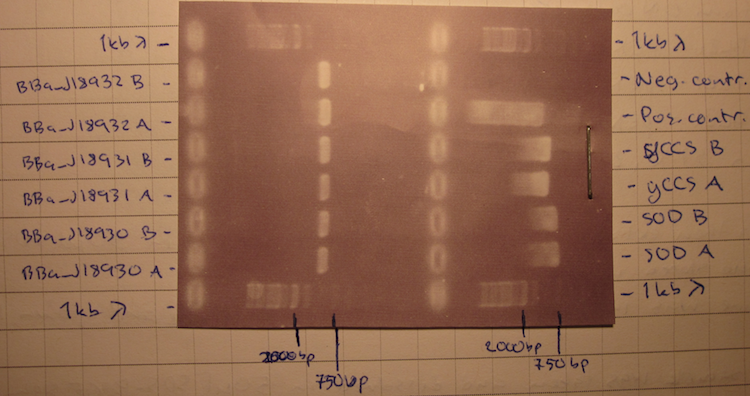Team:Stockholm/16 July 2010
From 2010.igem.org
Contents |
Andreas
LMWP ligation
Nina back from vacation and we decided to start working harder on making our CPPs. We divided TAT, Transportan10 and LMWP between us; I got LMWP.
LMWP primer dilutions
All LMWP primers were diluted 100x and 1000x, to yield concentrations of ≈1.0 and 0.1 μM, respectively:
| Primer | Original conc. | 100x dil. conc. | 1000x dil. conc. |
| LMWP_C_F1 | 109 mM | 1.09 mM | 0.11 mM |
| LMWP_N_F1 | 141 mM | 1.41 mM | 0.14 mM |
| LMWP_CN_R1 | 131 mM | 1.31 mM | 0.13 mM |
| LMWP_CN_F2 | 120 mM | 1.20 mM | 0.12 mM |
| LMWP_C_R2 | 119 mM | 1.19 mM | 0.12 mM |
| LMWP_N_R2 | 139 mM | 1.39 mM | 0.14 mM |
Flanking primers are designed with EcoRI and PstI overhangs, allowing me to use the linearized pSB1C3 vector for the ligation reaction.
Ligation
LMWP designed in two versions:
- C-LMWP containing the standard Freiburg prefix.
- N-LMWP containing the Freiburg N-part prefix.
Two ligation reactions performed for each LMWP version: (1) with high concentration primers (100x dil.) and (2) with low concentration primers (1000x dil.).
Ligation mixes
| Ingredient | C-LMWP (high conc.) [μl] | N-LMWP (high conc.) [μl] | C-LMWP (low conc.) [μl] | N-LMWP (low conc.) [μl] |
| pSB1C3 vector (25 ng/μl) | 2 | 2 | 2 | 2 |
| LMWP_C_F1 | 1 | 0 | 1 | 0 |
| LMWP_CN_R1 | 1 | 1 | 1 | 1 |
| LMWP_CN_F2 | 1 | 1 | 1 | 1 |
| LMWP_C_R2 | 1 | 0 | 1 | 0 |
| LMWP_N_R2 | 0 | 1 | 0 | 1 |
| 2X Quick Ligase buffer | 10 | 10 | 10 | 10 |
| dH2O | 3 | 3 | 3 | 3 |
| Quick Ligase (added later) | 1 | 1 | 1 | 1 |
| Total volume | 20 | 20 | 20 | 20 |
Procedures
- Denaturation: 95°C, 10 min
- Temperature slowly lowered to 65°C
- Annealing: 65°C, 5 min
- Temperature slowly lowered to RT (≈27°C)
- Ligation: Quick Ligase added
- 25°C, 10 min
- Transformation: 6 μl ligation mix into Top10. Cells grown on LB agar + 25 μg/ml Cm.
Colony PCR verification of pSB1x3 constructs from 13/7 colonies
pSBX verification primers VF2 and VR arrived. Decided to verify clones from 13/7 by colony PCR.
Colony PCR
From 13/7 colonies, pSB1x3
Picked new colonies from LB agar plates. Since the plates had now been left a few days in 4°C, the white (positive) clones were easier to discern from the red, as the red colonies now had a deeper red color.
Picked colonies were dissolved in 10 μl LB:
- pSB1C3.BBa_J18930 A
- pSB1C3.BBa_J18930 B
- pSB1C3.BBa_J18931 A
- pSB1C3.BBa_J18931 B
- pSB1C3.BBa_J18932 A
- pSB1C3.BBa_J18932 B
- pSB1C3.SOD A
- pSB1C3.SOD B
- pSB1C3.yCCS A
- pSB1C3.yCCS B
I decided not to pick the pSB1K3 and pSB1A3 constructs, as it is better to first verify single clones in one vector, and later transfer them to other vectors when needed.
PCR tubes - illustra PuReTaq Ready-To-Go™ PCR Beads:
- 1 μl 10 μM VF2 forward primer
- 1 μl 10 μM VR reverse primer
- 22.5 μl dH2O
- 0.5 μl cell suspension
- Positive control: 0.5 μl pSB1A3.BBa_J04450, pure plasmid
- Negative control: 0.5 μl dH2O
PCR settings
- Denaturation: 95°C - 10:00
- Denaturation: 95°C - 01:00
- Annealing: 55°C - 00:30
- Elongation: 72°C - 01:30
- Cycle back to step 2 29 times
- Elongation: 72°C - 10:00
- 15°C - ∞
Gel verification
1 % agarose, 90 V, 40 min
Results
Expected sizes (including ≈300 bp from vector):
- BBa_J18930: 1040 bp
- BBa_J18931: 1040 bp
- BBa_J18932: 1030 bp
- SOD: 795 bp
- yCCS: 1085 bp
- BBa_J04450: 1400 bp
Results correspond well to expected fragment sizes (see attached gel image).
ON cultures of verified clones
ON cultures (5 ml + 25 μg/ml Cm) were set for plasmid prep. and glycerol stock prep.
 |

|
 |

|
 |

|

|

|
 "
"



